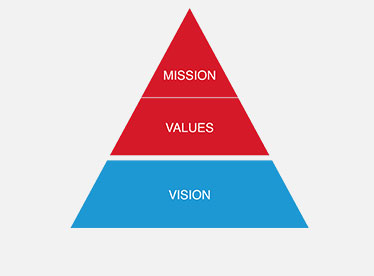-
Products
-
Transportation & Mobility Solutions
Transportation & Mobility Solutions
At Hitachi, we engineer industry-leading transportation and mobility solutions by leveraging decades of knowledge and using high-quality automotive material and components.
-
Energy Solutions
Energy Solutions
We believe the only solution for fulfilling the growing power requirements of industries and society is through a comprehensive portfolio of sustainable energy solutions and delivering innovative high-efficiency energy systems.
-
IT Infrastructure Services
IT Infrastructure Services
Hitachi’s state-of-the-art IT products and services are known to streamline business processes which result in better productivity and a higher return on investment (ROI).
-
Social Infrastructure: Industrial Products
Social Infrastructure: Industrial Products
Within the industrial sector, Hitachi is consistently delivering superior components and services, including industrial and automation solutions, useful in manufacturing facilities.
-
Healthcare & Life Sciences
Healthcare & Life Sciences
At Hitachi, we believe that healthcare innovation is crucial to a society’s advancement. A strong healthcare sector is often considered an inseparable element of a developed society.
-
Scientific Research & Laboratory Equipments
Scientific Research & Laboratory Equipments
Hitachi focuses on extensive research and development, transformative technology, and systems innovation to unfold new possibilities and create new value through scientific endeavors that strengthen the connection between science and social progress.
-
Smart Audio Visual Products
Smart Audio Visual Products
Since 1956, Hitachi audio visual products have provided state of the art solutions to consumers all over the world. It has been our pleasure to design competitive products at the lowest possible prices while maintaining our industry-leading quality standards for your comfort and enjoyment.
-
View All Products
Hitachi Products & Solutions
Hitachi, a technology leader in the U.S., offers a diverse set of products and solutions, and breakthrough technologies for smart manufacturing, green energy and mobility solutions that empower governments, businesses, and communities.
-
Transportation & Mobility Solutions
- Social Innovation Solutions
-
About Us
-
Hitachi in the U.S.A.
Hitachi in the U.S.A.
Discover information about the Hitachi group network across the Americas, upcoming events and sustainability endeavours, CSR policies, and corporate government relations.
-
About Hitachi Group
About Hitachi Group
Explore our leadership team, investor relations, environmental vision, and sustainability goals. Learn how Hitachi is leveraging its research & development capabilities for social innovation across industry verticals.
-
Hitachi in the U.S.A.
- News Releases
- Case Studies
- Careers
- R&D
Hitachi Announces Consolidated Financial Results for the Second Quarter ended September 30, 2011
Tokyo, November 1, 2011 --- Hitachi, Ltd. (NYSE:HIT / TSE:6501) today announced its consolidated financial results for the second quarter of fiscal 2011, ended September 30, 2011.
Notes:
1. All figures, except for the outlook for fiscal 2011, were converted at the rate of 77 yen to the U.S. dollar, the approximate exchange rate on the Tokyo Foreign Exchange Market as of September 30, 2011.
2. Operating income is presented in accordance with financial reporting principles and practices generally accepted in Japan.
In millions of yen and U.S. dollars, except Net income attributable to Hitachi, Ltd. stockholders per share (6) and Net income attributable to Hitachi, Ltd. stockholders per American Depositary Share (7).
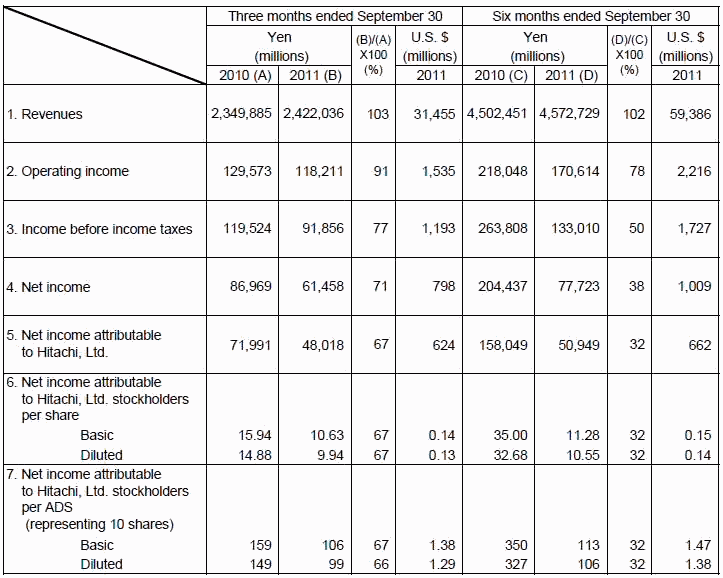
Notes:
1. The Company's consolidated financial statements are prepared based on U.S.GAAPs.
2. Operating income is presented in accordance with financial reporting principles and practices generally accepted in Japan.
3. The figures are for 949 consolidated subsidiaries, including Variable Interest Entities, and 178 equity-method affiliates.
Consolidated trust accounts are not included into the figures of consolidated subsidiaries.
1. Qualitative Information Concerning Consolidated Business Results
(1) Summary of Fiscal 2011 Second-Quarter (Three Months Ended September 30, 2011) and First-Half (Six Months Ended September 30, 2011) Consolidated Business Results
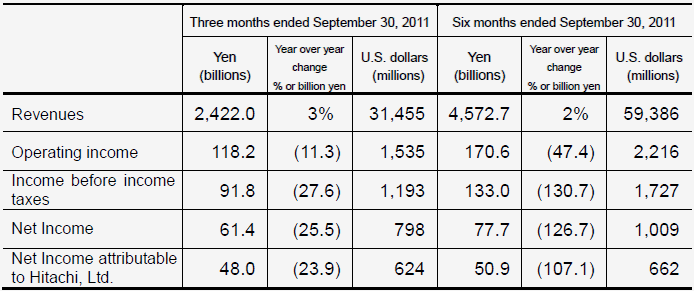
During the first half of fiscal 2011, the Hitachi Group suffered damage to a large number of buildings and production facilities caused by the Great East Japan Earthquake, which struck on March 11, 2011. However, due to cohesive group-wide efforts to quickly restore operations, production resumed across the board at most sites by the end of April 2011. The Hitachi Group also helped in various ways to support affected areas recover quickly from the disaster, including providing support for the resumption of power, telecommunications, water and sewage, information systems and other infrastructure. At the same time, the Hitachi Group used its products and services to provide support, such as by providing flat-panel TVs, dry-cell batteries, and disaster victim support systems for local authorities free of charge.
Hitachi’s consolidated revenues for the first half of fiscal 2011 rose 2% year over year, to 4,572.7 billion yen, despite most segments being hit hard by the Great East Japan Earthquake. One reason was higher revenues in the Others Segment, resulting from Hitachi Transport System, Ltd. making Vantec Corporation a consolidated subsidiary in April 2011, as well as strong growth in third-party logistics solutions. In addition, the Information & Telecommunication Systems Segment saw strong revenue growth, notably in storage solutions for overseas customers, and the Construction Machinery Segment produced higher revenues year over year, mainly in emerging countries.
Overseas revenues increased 1% year over year, to 2,000.3 billion yen.
Hitachi posted operating income of 170.6 billion yen, down 47.4 billion yen from the first half of fiscal 2010, even though the Automotive Systems, Construction Machinery, and Electronic Systems & Equipment segments posted higher year over year earnings. This reflected the large impact of the Great East Japan Earthquake and strong yen, which caused lower earnings in the Components & Devices, High Functional Materials & Components, and Power Systems segments, and others.
Hitachi posted net other deductions of 37.6 billion yen, 83.3 billion yen worse than the net other income in the corresponding period of the previous fiscal year. The year over year change was attributable to gains on the sale of securities recorded in the first half of fiscal 2010 resulting from the transfer of shares of IPS Alpha Technology, Ltd. to Panasonic Corporation, while there were no large sales of shares in the first half of fiscal 2011. Hitachi recorded income before income taxes of 133.0 billion yen, 130.7 billion yen less year over year. After taxes of 55.2 billion yen, Hitachi posted net income of 77.7 billion yen, a year over year decline of 126.7 billion yen. After deducting net income attributable to noncontrolling interests of 26.7 billion yen, Hitachi posted net income attributable to Hitachi, Ltd. of 50.9 billion yen, down 107.1 billion yen.
For the second quarter of fiscal 2011, the three months ended September 30, 2011, consolidated revenues were up 3% year over year, at 2,422.0 billion yen. Operating income declined 11.3 billion yen year over year, to 118.2 billion yen, despite all business segments recording profits. Hitachi recorded net income attributable to Hitachi, Ltd. of 48.0 billion yen, a 23.9 billion yen decline year over year.
(2) Revenues and Operating Income by Segment
Results by segment were as follows:
[Information & Telecommunication Systems]

For the first half of fiscal 2011, the segment recorded revenues of 797.0 billion yen, an increase of 3% year over year. The higher overall revenues resulted from increased sales of software and services for storage, mainly for overseas customers, which lifted software and services revenues year over year.
Segment operating income declined 3.5 billion yen year over year to 31.0 billion yen, due to the impact of the Great East Japan Earthquake and other factors.
For the second quarter of fiscal 2011, the segment recorded revenues of 446.2 billion yen, up 5% year over year. Segment operating income was 28.9 billion yen, down 5.4 billion yen year over year.
[Power Systems]

For the first half of fiscal 2011, segment revenues dropped 3% year over year, to 372.4 billion yen. This primarily reflected lower sales of nuclear power generation systems in the aftermath of the Great East Japan Earthquake. However, sales of thermal power generation systems were healthy in Japan.
The segment recorded operating income of 0.6 billion yen, down 13.7 billion yen year over year, reflecting the impact of the Great East Japan Earthquake and lower revenues.
For the second quarter of fiscal 2011, the segment recorded revenues of 206.1 billion yen, which was largely unchanged year over year. Segment operating income was 3.8 billion yen, down 5.8 billion yen year over year.
[Social Infrastructure & Industrial Systems]

For the first half of fiscal 2011, the segment recorded revenues of 513.5 billion yen, a 1% increase year over year, despite lower sales of plant-related equipment and construction. The year over year increase reflected higher sales of railway systems, mainly for overseas markets, and strong sales of industrial equipment for the manufacturing industry.
The segment posted operating income of 6.3 billion yen, down 4.4 billion yen year over year, on account of lower sales of plant-related equipment and construction.
For the second quarter of fiscal 2011, revenues rose 2% year over year, to 283.7 billion yen. Operating income declined 2.8 billion yen year over year to 5.3 billion yen.
[Electronic Systems & Equipment]

For the first half of fiscal 2011, the segment recorded revenues of 533.5 billion yen, a 1% increase year over year, despite lower sales in the display-related products and parts and components sales businesses at Hitachi High-Technologies Corporation. The higher segment revenues reflected mainly the consolidation of Aloka Co., Ltd. in January 2011 by Hitachi Medical Corporation.
Segment operating income improved 5.0 billion yen year over year, to 21.3 billion yen, reflecting higher earnings at Hitachi Kokusai Electric Inc. and Hitachi Koki Co., Ltd., mainly due to progress with cost cutting programs.
For the second quarter of fiscal 2011, segment revenues rose 3%, to 287.4 billion yen. Operating income improved 3.2 billion yen year over year, to 14.1 billion yen.
[Construction Machinery]

For the first half of fiscal 2011, the segment recorded revenues of 355.8 billion yen, up 6% year over year, despite lower demand in China for hydraulic excavators and the impact of the yen’s appreciation. The overall increase reflected higher unit sales of hydraulic excavators, driven by strong demand in emerging countries in Asia and elsewhere, and in the Japanese and U.S. markets, notably the rental industry.
Segment operating income improved 7.6 billion yen, to 25.8 billion yen, due to higher sales of services and parts and components, centered on mining machinery, and due to cost cutting.
For the second quarter of fiscal 2011, segment revenues rose 6% year over year, to 183.3 billion yen. Operating income improved 3.5 billion yen, to 14.8 billion yen.
[High Functional Materials & Components]

For the first half of fiscal 2011, the segment recorded revenues of 700.6 billion yen, largely unchanged from the corresponding period of the previous fiscal year. Sales declined at Hitachi Chemical Co., Ltd. due to lower semiconductor- and LCD-related demand, as well as lower automobile production because of the Great East Japan Earthquake. On the other hand, Hitachi Metals, Ltd. and Hitachi Cable, Ltd. recorded higher sales year over year.
Segment operating income declined 16.4 billion yen, to 33.8 billion yen. This reflected year over year declines in earnings at Hitachi Chemical, Hitachi Metals and Hitachi Cable because of the impact of the Great East Japan Earthquake, along with lower sales stemming from lower electronics-related demand, including semiconductor- and LCD-related demand.
For the second quarter of fiscal 2011, revenues were largely flat year over year at 353.5 billion yen. Segment operating income declined 9.5 billion yen to 14.4 billion yen.
[Automotive Systems]

For the first half of fiscal 2011, the segment recorded revenues of 388.1 billion yen, up 2% year over year, despite the impact of a drop in automobile production in Japan after the Great East Japan Earthquake at the beginning of the fiscal year. This increase primarily reflected increased demand in step with a recovery in automobile production in Japan in the second quarter, and strong growth in sales of lithium-ion batteries for smartphones.
Segment operating income improved 9.0 billion yen to 14.7 billion yen, reflecting mainly the benefits of cost reductions.
For the second quarter of fiscal 2011, segment revenues increased 6%, to 210.9 billion yen. Operating income improved 8.9 billion yen to 12.6 billion yen.
Note: Effective from April 1, 2011, there was a change in segmentation between the Automotive Systems and the Components & Devices segments. Figures for each segment, including figures for the first half of fiscal 2010, reflect the new segmentations.
[Components & Devices]

For the first half of fiscal 2011, the segment recorded revenues of 367.4 billion yen, down 7% year over year, as HDD operations posted lower sales due to lower sales prices.
Segment operating income dropped 22.9 billion yen, to 12.6 billion yen, on account of lower HDD earnings resulting from decreased sales.
For the second quarter of fiscal 2011, segment revenues declined 6%, to 189.6 billion yen. Operating income declined 8.8 billion yen to 7.6 billion yen.
Notes
1: Effective from April 1, 2011, there was a change in segmentation between the Automotive Systems and the Components & Devices segments. Figures for each segment, including figures for the first half of fiscal 2010, reflect the new segmentations.
2: HDD operations are conducted by Hitachi Global Storage Technologies (Hitachi GST), which has a December 31 fiscal year-end, different from Hitachi’s March 31 year-end. Hitachi’s results for the six months ended September 30, 2011 include operating results of Hitachi GST for the six months ended June 30, 2011.
[Digital Media & Consumer Products]

For the first half of fiscal 2011, the segment recorded revenues of 471.3 billion yen, down 7% year over year. Optical disk drive-related products recorded lower sales year over year, which was the result of parts and components shortages after the Great East Japan Earthquake and the yen’s appreciation. Another factor was lower year over year sales of flat-panel TVs due to lower sales prices and other factors. However, commercially packaged air conditioners posted higher sales, mainly in Japan, spurred by demand for upgrading to energy-saving models.
Segment operating income declined 5.7 billion yen to 5.2 billion yen, reflecting decreased earnings from optical disk drive-related products and flat-panel TVs in line with lower sales.
For the second quarter of fiscal 2011, segment revenues declined 5% year over year, to 238.2 billion yen. Operating income declined 1.9 billion yen year over year, to 1.9 billion yen.
Note: The optical disk drive operations are conducted by Hitachi-LG Data Storage, Inc. (HLDS), which has a December 31 fiscal year-end, different from Hitachi’s March 31 year-end. Hitachi’s results for the six months ended September 30, 2011 include operating results of HLDS for the six months ended June 30, 2011.
[Financial Services]

For the first half of fiscal 2011, the segment recorded revenues of 181.4 billion yen, down 3% year over year. This overall decline reflected lower revenues in the finance services business in Japan at Hitachi Capital Corporation in the aftermath of the Great East Japan Earthquake as well as the impact of foreign currency fluctuations. However, the overseas business and certain other businesses at Hitachi Capital produced strong performances, mainly in Asia.
Segment operating income improved 2.9 billion yen, to 14.1 billion yen, reflecting higher earnings at Hitachi Capital because of increased revenues from the overseas and new businesses, and reduced financing and credit costs.
For the second quarter of fiscal 2011, segment revenues declined 4% year over year, to 88.9 billion yen. Operating income improved 1.1 billion yen to 7.2 billion yen.
[Others]

For the first half of fiscal 2011, the segment recorded revenues of 467.8 billion yen, up 25% year over year, on healthy growth in sales in third-party logistics solutions, in addition to the effect of Hitachi Transport System, Ltd. making Vantec Corporation a consolidated subsidiary in April 2011.
Segment operating income improved 3.5 billion yen, to 16.3 billion yen. This reflected higher earnings on higher revenues at Hitachi Transport System.
For the second quarter of fiscal 2011, segment revenues increased 23% year over year to 240.8 billion yen. Operating income improved 3.7 billion yen, to 10.5 billion yen.
(3) Revenues by Market
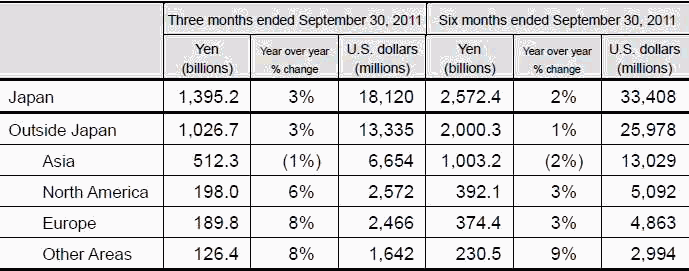
For the first half of fiscal 2011, revenues in Japan were 2,572.4 billion yen, up 2% year over year. The Others Segment posted higher revenues at Hitachi Transport System, Ltd. due to the consolidation of Vantec Corporation and strong sales growth in third-party logistics solutions, and others. However, the Components & Devices, and Electronic Systems & Equipment segments saw revenues decline.
Outside Japan revenues increased 1% year over year, to 2,000.3 billion yen. The consolidation of Vantec at Hitachi Transport System led to higher revenues in the Others Segment, and the Electronic Systems & Equipment and Information & Telecommunication Systems segments posted higher revenues. However, revenues declined in the Digital Media & Consumer Products and Power Systems segments.
As a result, the ratio of overseas revenues to consolidated revenues was 44%, flat year over year.
For the second quarter of fiscal 2011, revenues in Japan rose 3% year over year, to 1,395.2 billion yen. Overseas revenues increased 3%, to 1,026.7 billion yen.
(4) Capital Investment, Depreciation and R&D Expenditures
Capital investment on a completion basis, excluding leasing assets, increased 29% year over year, to 154.6 billion yen, primarily due to investments for stepping up global business development.
Depreciation, excluding leasing assets, decreased 12% year over year, to 132.2 billion yen, primarily due to strict selection of capital investments.
R&D expenditures increased 2% year over year, to 199.1 billion yen, which corresponded to 4.4% of consolidated revenues. The increase was due mainly to further R&D investment to strengthen the Social Innovation Business.
For the second quarter of fiscal 2011, capital investment on a completion basis, excluding leasing assets, increased 29%, to 94.8 billion yen. Depreciation, excluding leasing assets, decreased 14%, to 65.0 billion yen. R&D expenditures increased 3%, to 105.0 billion yen, and corresponded to 4.3% of consolidated revenues.
2. Financial Position
(1) Financial Position
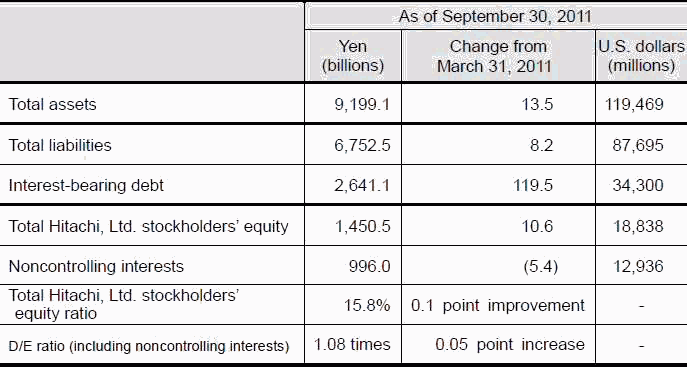
Total assets as of September 30, 2011 increased 13.5 billion yen from March 31, 2011, to 9,199.1 billion yen, due mainly to the consolidation of Vantec Corporation by Hitachi Transport System, Ltd. Interest-bearing debt increased 119.5 billion yen, to 2,641.1 billion yen, because of an increase in short-term debt, mainly in the form of commercial paper, to provide additional working capital. Stockholders’ equity increased 10.6 billion yen, to 1,450.5 billion yen. As a result, the total Hitachi, Ltd. stockholders’ equity ratio was 15.8%. The debt-to-equity ratio, including noncontrolling interests, was 1.08.
(2) Cash Flows

Operating activities provided net cash of 93.1 billion yen, a 284.4 billion yen decrease year over year. This result is mainly reflecting decrease in net income and an increase in working capital.
Investing activities used net cash of 221.7 billion yen, 116.1 billion yen more than in the corresponding period of the previous fiscal year. This result mainly reflected outflows for the acquisition of BlueArc Corporation and Vantec Corporation.
Free cash flows, the sum of cash flows from operating and investing activities, was negative 128.6 billion yen.
Financing activities provided net cash of 104.0 billion yen, a change of 297.9 billion yen from the net cash used in the corresponding period of the previous fiscal year. This change mainly reflected the increase in short-term debt mainly from the issue of commercial paper.
The net result of the above items was a decrease of 44.1 billion yen in cash and cash equivalents during the six-month period, to 510.6 billion yen.
3. Outlook for Fiscal 2011
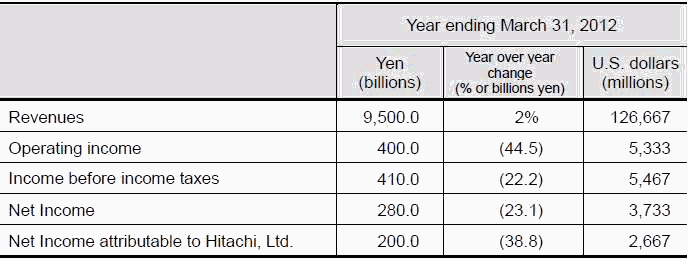
Note: All fiscal 2011 outlook figures were converted using 75 yen to the U.S. dollar.
Hitachi has not revised its previous forecasts for fiscal 2011 announced on July 29, 2011 because of considerable uncertainty surrounding trends in the global economy, especially in the U.S., Europe and China, the impact of damage from flooding in Thailand, foreign currency fluctuations, and fluctuations in raw materials prices.
Hitachi is assuming exchange rates of 75 yen to the U.S. dollar and 105 yen to the euro for the third and fourth quarters of fiscal 2011.
Other
(1) Changes in significant subsidiaries during the period (changes in specified subsidiaries causing changes in scope of consolidation)
None
(2) Application of simple accounting treatment and/or specific accounting treatment in preparing the quarterly consolidated financial statements
Yes
(3) Changes in accounting principles, procedures and presentation methods for preparing quarterly consolidated financial statements.
Yes
Cautionary Statement
Certain statements found in this document may constitute “forward-looking statements” as defined in the U.S. Private Securities Litigation Reform Act of 1995. Such “forward-looking statements” eflect management’s current views with respect to certain future events and financial performance and include any statement that does not directly relate to any historical or current fact. Words such as “anticipate,” “believe,” “expect,” “estimate,” “forecast,” “intend,” “plan,” “project” and similar expressions which indicate future events and trends may identify “forward-looking statements.” Such statements are based on currently available information and are subject to various risks and uncertainties that could cause actual results to differ materially from those projected or implied in the “forward-looking statements” and from historical trends. Certain “forward-looking statements” are based upon current assumptions of future events which may not prove to be accurate. Undue reliance should not be placed on “forward-looking statements,” as such statements speak only as of the date of this document.
Factors that could cause actual results to differ materially from those projected or implied in any “forward-looking statement” and from historical trends include, but are not limited to:
• economic conditions, including consumer spending and plant and equipment investment in Hitachi’s major markets, particularly Japan, Asia, the United States and Europe, as well as levels of demand in the major industrial sectors Hitachi serves, including, without limitation, the information, electronics, automotive, construction and financial sectors;
• exchange rate fluctuations of the yen against other currencies in which Hitachi makes significant sales or in which Hitachi’s assets and liabilities are denominated, particularly against the U.S. dollar and the euro;
• uncertainty as to Hitachi’s ability to access, or access on favorable terms, liquidity or long-term financing;
• uncertainty as to general market price levels for equity securities in Japan, declines in which may require Hitachi to write down equity securities that it holds;
• the potential for significant losses on Hitachi’s investments in equity method affiliates;
• increased commoditization of information technology products and digital media-related products and intensifying price competition for such products, particularly in the Components & Devices and the Digital Media & Consumer Products segments;
• uncertainty as to Hitachi’s ability to continue to develop and market products that incorporate new technologies on a timely and cost-effective basis and to achieve market acceptance for such products;
• rapid technological innovation;
• the possibility of cost fluctuations during the lifetime of, or cancellation of, long-term contracts for which Hitachi uses the percentage-of-completion method to recognize revenue from sales;
• fluctuations in the price of raw materials including, without limitation, petroleum and other materials, such as copper, steel, aluminum, synthetic resins, rare metals and rare-earth minerals, or shortages of materials, parts and components;
• fluctuations in product demand and industry capacity;
• uncertainty as to Hitachi’s ability to implement measures to reduce the potential negative impact of fluctuations in product demand, exchange rates and/or price of raw materials or shortages of materials, parts and components;
• uncertainty as to Hitachi’s ability to achieve the anticipated benefits of its strategy to strengthen its Social Innovation Business;
• uncertainty as to the success of restructuring efforts to improve management efficiency by divesting or otherwise exiting underperforming businesses and to strengthen competitiveness and other cost reduction measures;
• general socioeconomic and political conditions and the regulatory and trade environment of countries where Hitachi conducts business, particularly Japan, Asia, the United States and Europe, including, without limitation, direct or indirect restrictions by other nations on imports and differences in commercial and business customs including, without limitation, contract terms and conditions and labor relations;
• uncertainty as to the success of alliances upon which Hitachi depends, some of which Hitachi may not control, with other corporations in the design and development of certain key products;
• uncertainty as to Hitachi’s access to, or ability to protect, certain intellectual property rights, particularly those related to electronics and data processing technologies;
• uncertainty as to the outcome of litigation, regulatory investigations and other legal proceedings of which the Company, its subsidiaries or its equity method affiliates have become or may become parties;
• the possibility of incurring expenses resulting from any defects in products or services of Hitachi;
• the possibility of disruption of Hitachi’s operations in Japan by earthquakes, tsunamis or other natural disasters, including the possibility of continuing adverse effects on Hitachi’s operations as a result of the earthquake and tsunami that struck northeastern Japan on March 11, 2011;
• uncertainty as to Hitachi’s ability to maintain the integrity of its information systems, as well as Hitachi’s ability to protect its confidential information or that of its customers;
• uncertainty as to the accuracy of key assumptions Hitachi uses to evaluate its significant employee benefit-related costs; and
• uncertainty as to Hitachi’s ability to attract and retain skilled personnel.
The factors listed above are not all-inclusive and are in addition to other factors contained in Hitachi’s periodic filings with the U.S. Securities and Exchange Commission and in other materials published by Hitachi.
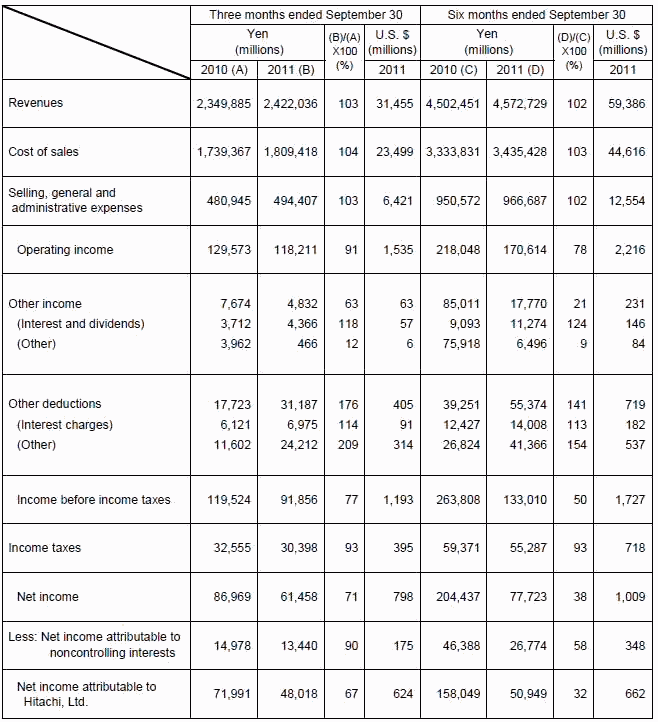
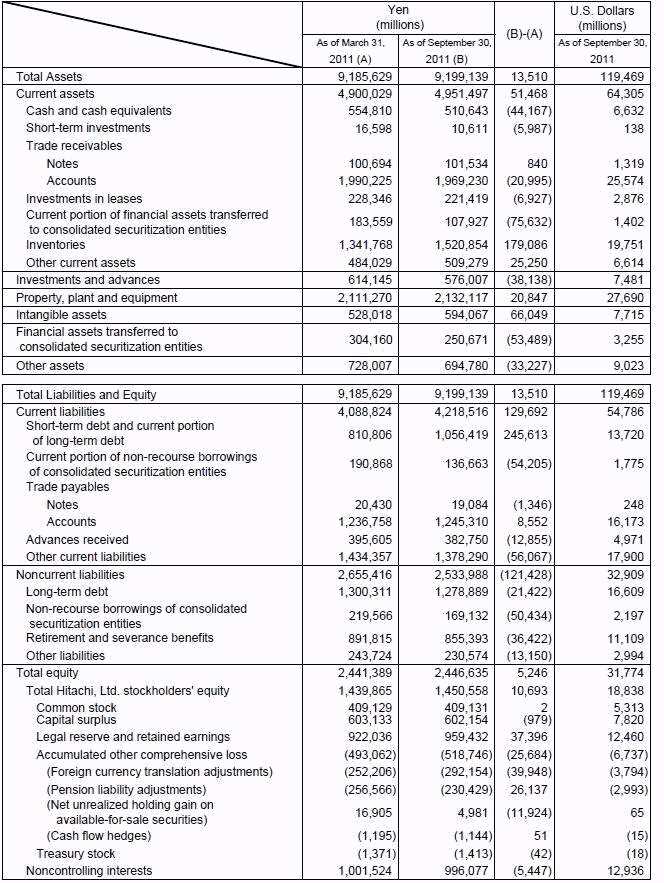
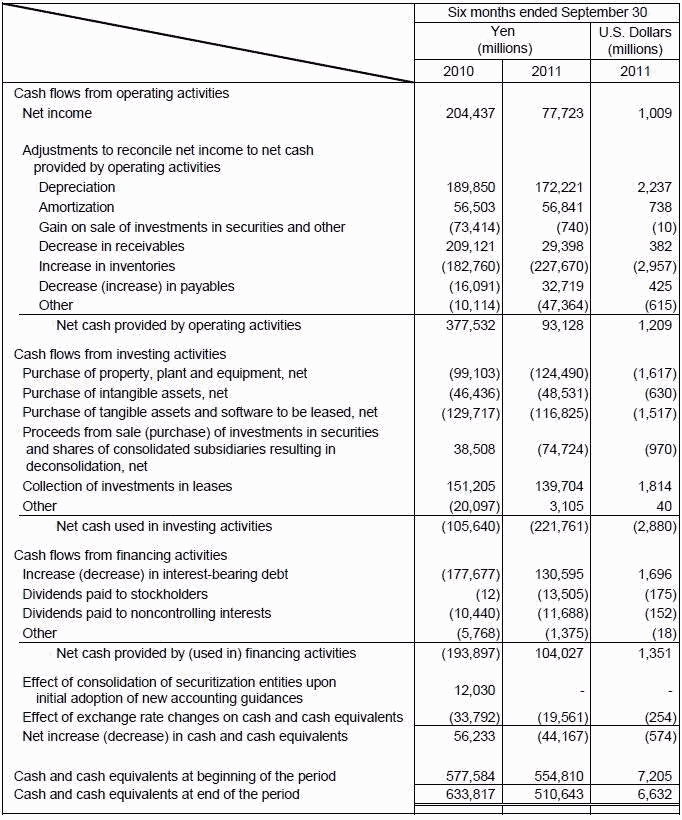
(1) Business Segments
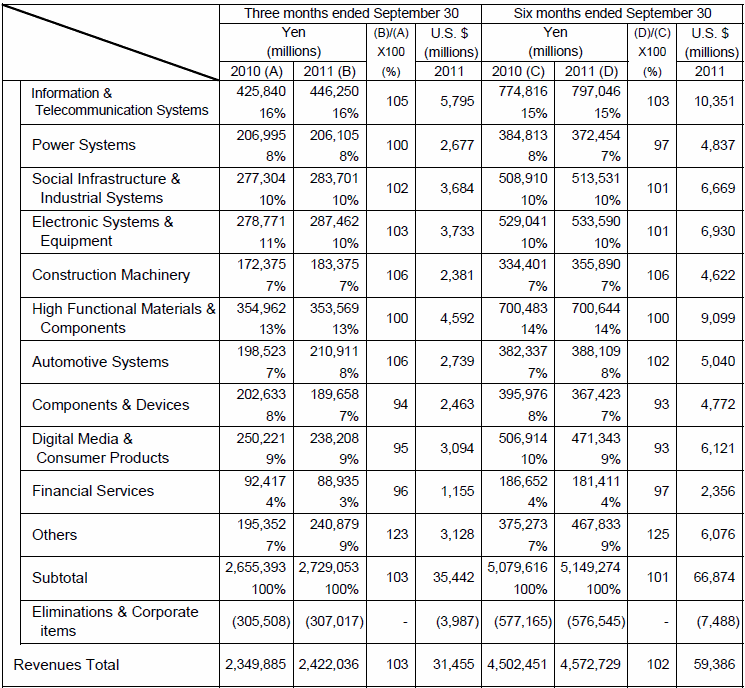
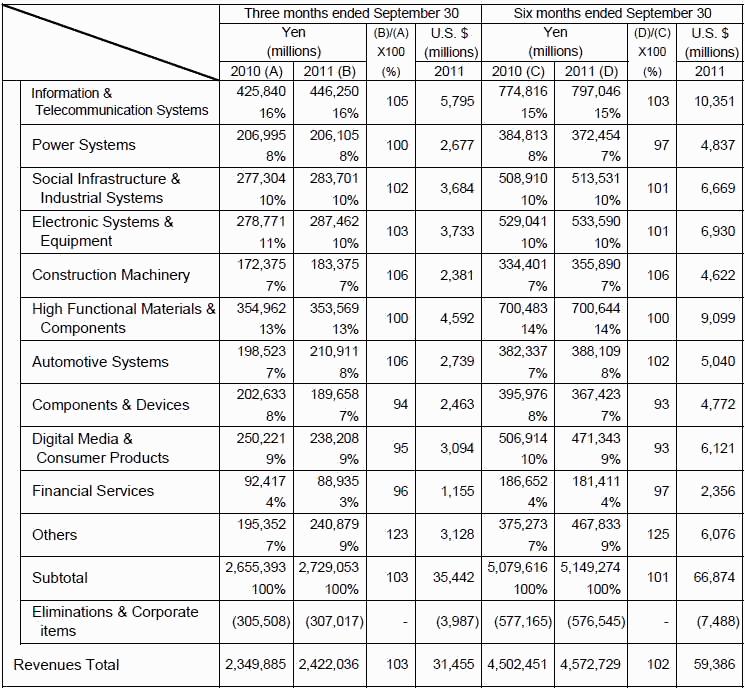
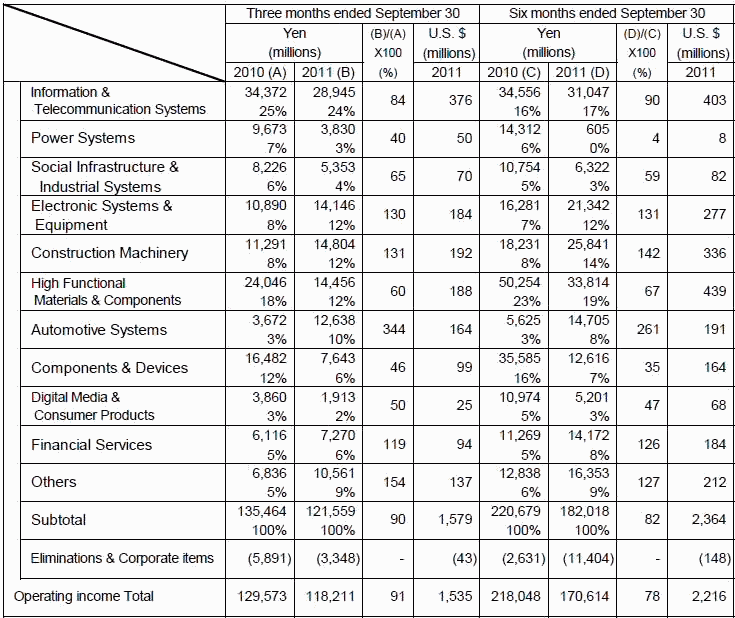
Notes
1: Revenues by business segment include intersegment transactions.
2: Starting from April 1, 2011, the Company has changed the business segment classification between the Automotive Systems Segment and the Components & Devices Segment. Figures of business segments, including the figures of previous fiscal year, have been restated to reflect the reclassification.
(2) Revenues by Market
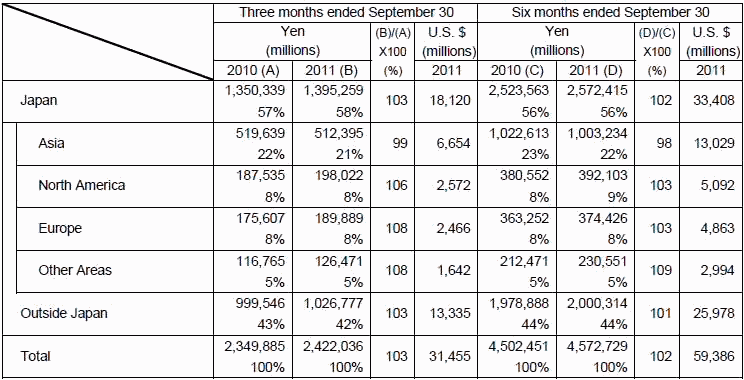

*1 Hitachi expects to close the transaction to transfer Hitachi’s hard disk drive business to Western Digital Corporation in the quarter ending December 2011.
The Hard Disk Drive operations are conducted by Hitachi Global Storage Technologies (Hitachi GST), which has a December 31 fiscal year-end, different from Hitachi's March 31 year-end.
Business forecasts for fiscal 2011, ending March 31, 2012 include the operating results of Hitachi GST for the nine months ending September 30, 2011.
*2 Billions of yen
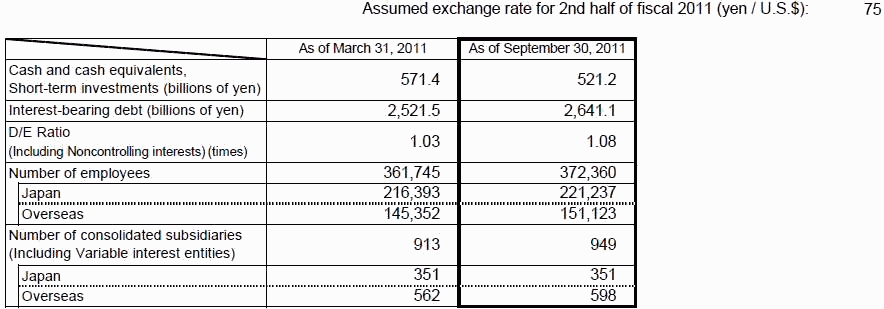
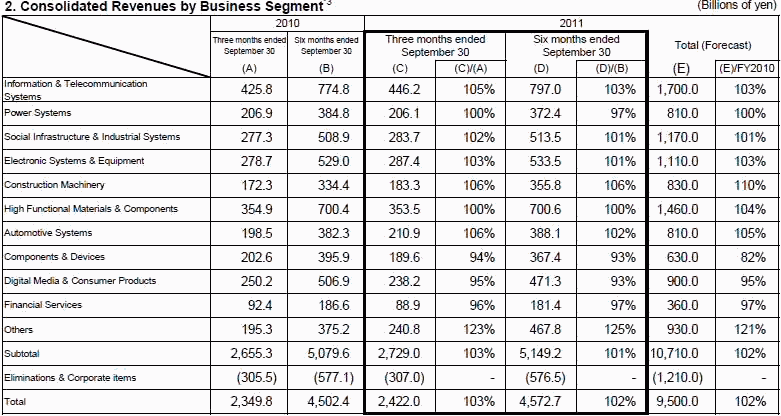
*3 Starting from April 1, 2011, the Company has changed the business segment classification between the Automotive Systems Segment and the Components & Devices Segment. Consolidated figures by business segment, including the figures of previous fiscal year, have been restated to reflect the reclassification.
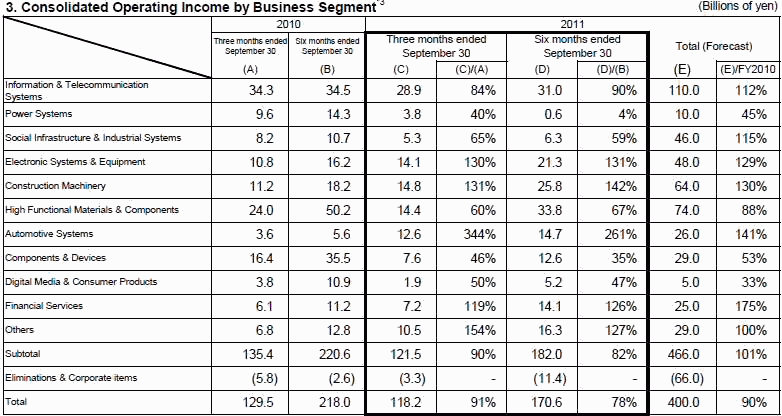
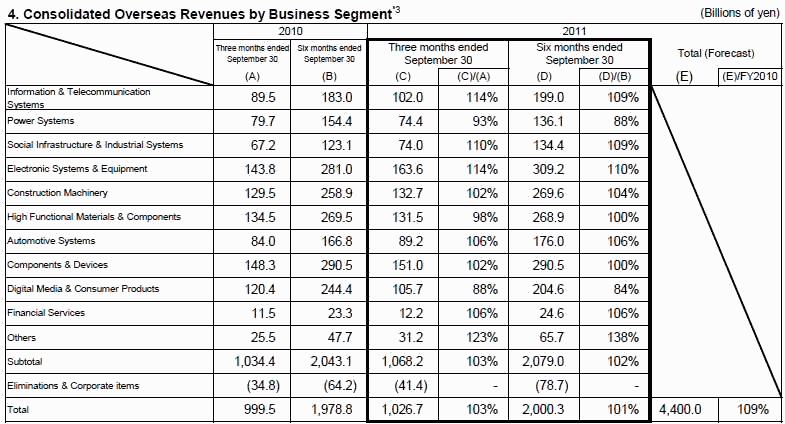
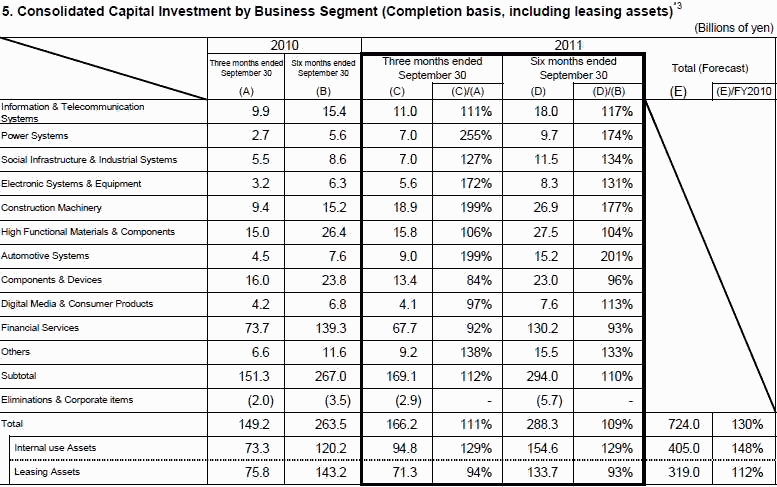
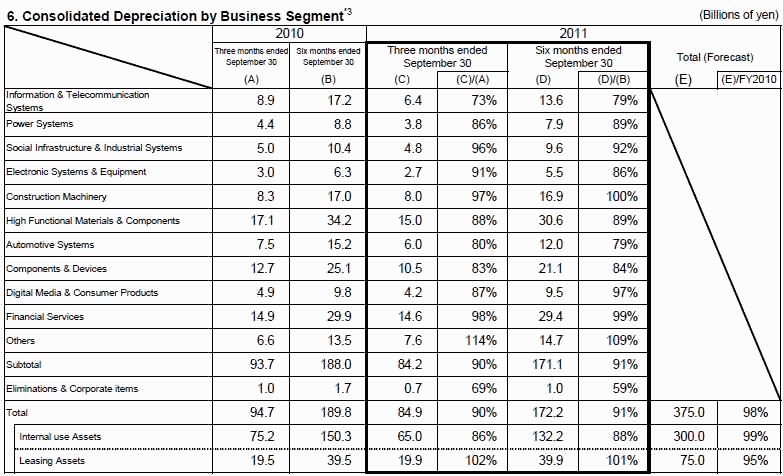
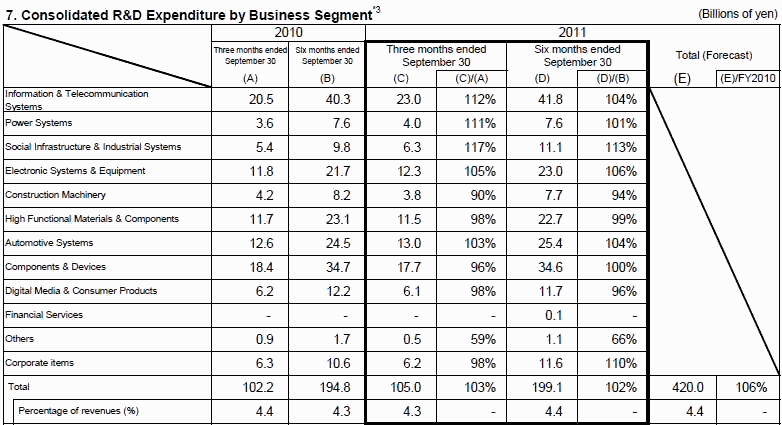
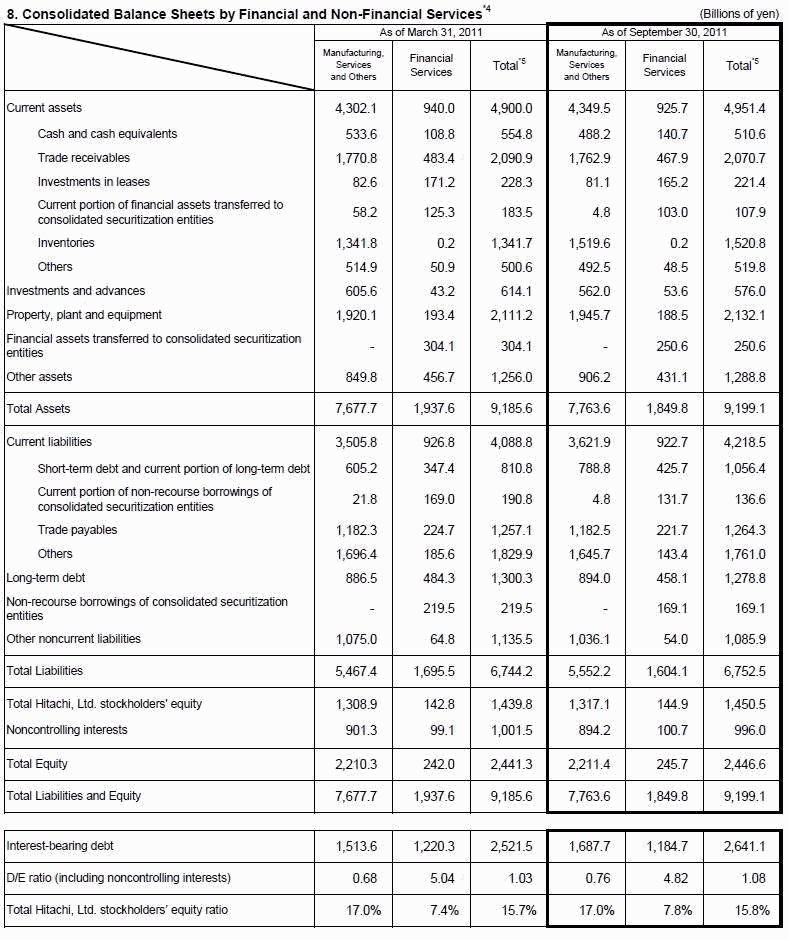
*4 Figures in tables 8, 9 and 10 represent unaudited financial information prepared by the Company for the purpose of this supplementary information.
*5 Total Figures exclude intra-segment transactions.
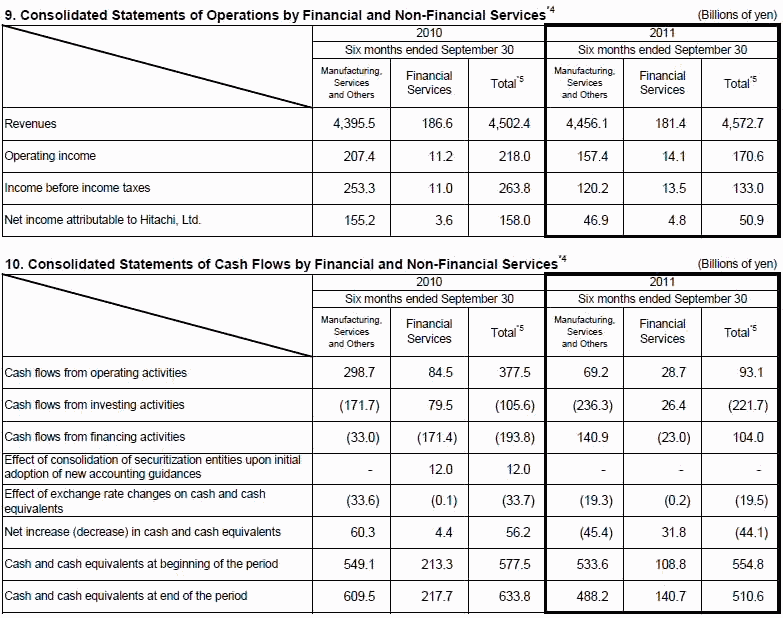
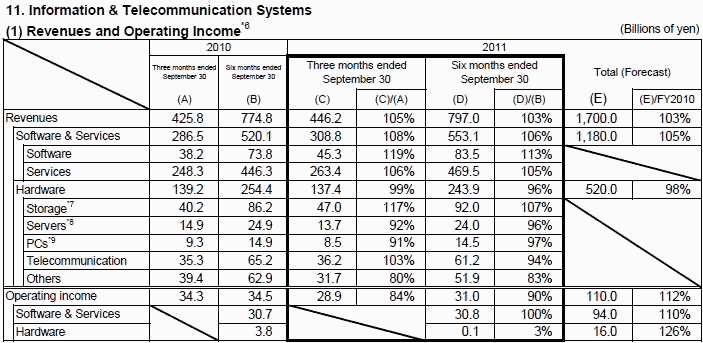
*6 Figures for each product exclude intra-segment transactions.
*7 Figures for Storage include disk array systems, etc.
*8 Figures for Servers include general-purpose computers, UNIX servers, etc.
*9 Figures for PCs include PC servers, client PCs (only commercial use), etc.
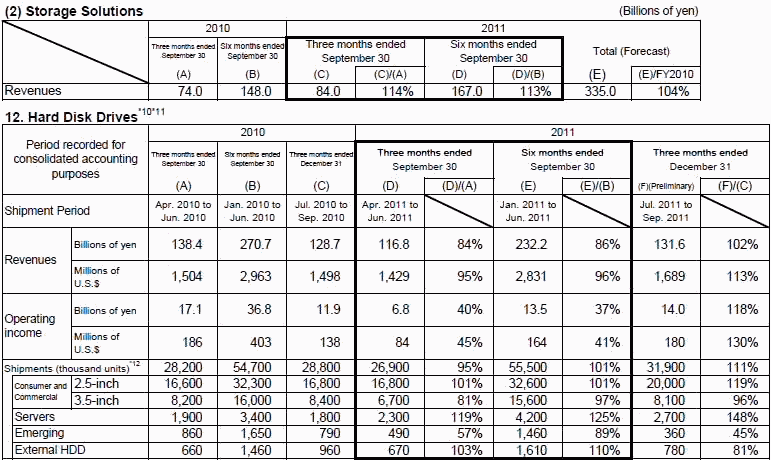
*10 The Hard Disk Drive operations are conducted by Hitachi Global Storage Technologies (Hitachi GST), which has a December 31 fiscal year-end, different from Hitachi's March 31 year-end. Hitachi's results for the six months ended September 30, 2011 include the operating results of Hitachi GST for the six months ended June 30, 2011.
*11 Hitachi GST's operating currency is U.S. dollar. Yen figures include yen / dollar conversion fluctuation.
*12 Shipment less than 100,000 units have been rounded, with the exception of Emerging and External HDD, where shipment less than 10,000 units have been rounded.
Japan
Masanao Sato
Hitachi, Ltd.
+81-3-5208-9324
masanao.sato.sz@hitachi.com
US
Mickey Takeuchi
Hitachi America, Ltd.
+1-914-333-2987
masayuki.takeuchi@hal.hitachi.com






